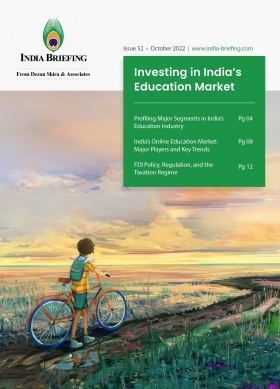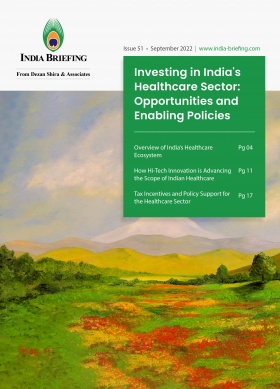India’s Per Capita Income for 2022-23 Doubles from 2014-15, but Wealth Unevenly Spread
India’s per capita net national income (at current prices) for 2022-23 stands at INR 172,000, according to estimates from the National Statistical Office (NSO). This marks an almost 100 percent increase from the per capita income in 2014-15 – INR 86,647 – when the Narendra Modi government first came to power.
Per capita incomes dipped during the outbreak of COVID-19, but picked up in 2021-22 and 2022-23. Yet, why have Indians not been feeling much wealthier?
That’s because wealth distribution across India’s 1.4 billion population remains highly skewed. Per capita income is commonly understood as the average income of a person in a specific area, a number that is reached by dividing total area income by its total population. So when the average income of some population segments increase, it inflates the per capita income.
In this article, we track some of the latest official data on India’s developing growth story.
What is India’s per capita income in real terms?
When accounting for constant prices [2011-12 prices], India’s per capita net national income (NNI) (in real terms), increased by about 35 percent from INR 72,805 in 2014-15 to INR 98,118 in 2022-23.
NNI is an indicator of the total economic activity in a country, and is defined by the OECD as gross national income minus the depreciation of fixed capital assets (dwellings, buildings, machinery, transport equipment and physical infrastructure) through wear and tear and obsolescence.
The below table from the NSO shows India’s per capita gross domestic income (GDP), per capital gross national income (GNI), and the per capita private financial consumption expenditure (PFCE) at 2011-12 prices between 2020-21 and 2022-23.
|
Per Capita Income, Product, and Final Consumption – Second Advance Estimates of National Income and Expenditure Components of GDP, 2022-23 (at 2011- 12 Prices) |
|||||
|
Item |
2020-21 (Second Revised Estimates) |
2021-22 (First Revised Estimates) |
2022-23 (Second Advanced Estimates) |
Percentage change over previous year |
|
|
2021-22 |
2022-23 |
||||
|
Population (in million) |
1355 |
1369 |
1383 |
|
|
|
Per capita GDP (INR) |
100,981 |
109,060 |
115,490 |
8.0% |
5.9% |
|
Per capita GNI (INR) |
99,578 |
106,822 |
113,144 |
7.3% |
5.9% |
|
Per capita NNI (INR) |
86,054 |
92,583 |
98,118 |
7.6% |
6.0% |
|
Per capita PFCE (INR) |
57,728 |
63,595 |
67,555 |
10.2% |
6.2% |
This data takes into account the impact of inflation. According to economists like Jayati Ghosh, most of the increase in income accrues to the “top 10 percent of the population” – which points to the challenge of wealth distribution in the country – a similar story in most high performing economies. The longer this trend continues in India, the more impacted will its economy be to the shocks emanating from the rise and fall in fortunes of the elite few. Sustainable development of the country necessitates higher standards of human development across all segments of society.
Uneven wealth distribution in India skews progress in per capita metrics
According to Oxfam’s “Survival of the Richest” report published on the opening day of the 2023 World Economic Forum at Davos, the top one percent in India owned more than 40.5 percent of total wealth in 2021 while the bottom 50 percent of the population (700 million) had around three percent of total wealth.
From the start of the pandemic to November 2022, Oxfam noted that billionaires in India witnessed a 121 percent growth in their wealth – INR 36.08 billion per day in real terms, as the number of impoverished [“hungry Indians”] grew from 190 million to 350 million.
Largely, India is still a rural-agrarian economy. According to the 2011 Census, close to 70 percent of the country’s population live in rural areas and around 54 percent of the population still depend on agriculture as their primary income source.
Inflation continues its uptick
As input prices and therefore production costs remain high, due to global uncertainties among other factors, companies in most industries are passing on higher spending to final consumers to preserve earnings margins.
This is why India is currently witnessing a K-shaped economic recovery post-pandemic as consumption is slowing down and household savings decline. Wage growth is also under pressure in the lower half of the income pyramid.
The RBI, meanwhile, is attempting to rein in the inflation with policy rate hikes.
The consumer price index (CPI) inflation reached 6.5 percent this January; it was 5.88 percent last November and 5.72 percent in December. India’s average inflation rate was 7.2 percent year-on-year for the first half of FY2022-23; it was 5.8 percent in the previous two years.
What is India’s nominal GDP per capita income?
|
Per Capita Income, Product, and Final Consumption – Second Advance Estimates of National Income and Expenditure Components of GDP, 2022-23 (at Current Prices)
|
|||||
|
Item |
2020-21 (Second Revised Estimates) |
2021-22 (First Revised Estimates) |
2022-23 (Second Advanced Estimates) |
Percentage change over previous year |
|
|
2021-22 |
2022-23 |
||||
|
Per capita GDP (INR) |
146,301 |
171,498 |
196,716 |
17.2% |
14.7% |
|
Per capita GNI (INR) |
144,334 |
168,066 |
192,777 |
16.4% |
14.7% |
|
Per capita NNI (INR) |
127,065 |
148,524 |
172,000 |
16.9% |
15.8% |
|
Per capita gross national disposable income (GNDI) (INR) |
148,408 |
172,490 |
197,409 |
16.2% |
14.4% |
|
Per capita PFCE (INR) |
89,641 |
104,811 |
119,106 |
16.9% |
13.6% |
Quoted by multiple media outlets, former director of the National Institute of Public Finance and Policy (NIPFP), Pinaki Chakraborty, refers to the database of the World Development Indicator when noting that the average growth of India’s per capita income in real term from 2014 to 2019 was 5.6 percent. Chakraborty asserted, however, that balanced regional development would be key to achieving higher economic growth.
The COVID-19 pandemic pushed many Indians on the lower rungs of the economic ladder into further poverty. The averages – like per capita metrics – often mask these severe income inequalities on the ground. As the government pursues redistributive policies, results need to be delivered on equitable access to healthcare, quality education, and jobs. Often, numbers get inflated during time of release near elections and budget season as welfare programs incentivize short term gigs.
Size of India’s economy fifth in the world
Still, in absolute terms, India remains a bright spot on the world stage, as it grows steadily from a relatively low base. Last year, India overtook the UK to become the world’s fifth biggest economy, after the US, China, Japan. and Germany.
Multiple initiatives to ease doing business and expand the manufacturing share of the economy as well as the push for skill development – offers promise to convert India’s human capital into a talent base that feeds higher quality development. According to its central bank, the Reserve Bank of India, at current prices and exchange rates, India will be a US$3.7 trillion economy in 2023, remaining fifth in the world standings.
Rise in spending share to GDP, but consumption basket dominated by food and non-durables
Another way of tracking India’s rising prosperity is looking at its consumption trends. The share of India’s domestic consumption to GDP was around ~60 percent in 2022, following ~68 percent in the US. Among other top economies, the domestic consumption to GDP share was ~54 percent in Japan, ~52 percent in Germany, and ~60 percent in the UK.
(According to the second advance estimates for India’s national income in FY 2022-23, private financial consumption expenditure as share of GDP (at 2011-12 prices), was 58.5 percent and at current prices, it was 60.5 percent.)
When analyzing the quality of consumption, it is clear that India is an emerging economy. The consumption mix in India sees a higher probable spend on necessities and less on luxury and comfort. Looking at the publicly available data, India’s consumption basket is dominated by spending on food at 30-32 percent share followed by transport at 15-17 percent, housing and utilities at 13-14 percent, and clothing, education, and health at 5 percent each. Consumption on services has a ~48-49 percent share and consumption on non-durable goods is at 44 percent. Durable and semi-durable items account for less than 10 percent aggregate share of overall consumption.
This can be contrasted with the US’ consumption basket, where household utilities have the highest share at 17 percent and spending on food is only 7-8 percent. Overall, spending on services accounts for the largest share at two-thirds of the consumption basket, non-durable items is at ~22 percent, and durable items at ~13 percent. Meanwhile, in the world’s fourth largest economy, Germany, food accounts for 15 percent share of the consumption basket and the highest share is spent on housing and utilities at ~25 percent, followed by transport and communication at 16-17 percent, and recreation at 10-11 percent.
Are women the missing link? Female labor force participation a blight on India’s growth story
According to World Bank figures for 2021, less than one in five Indian women are engaged in formal work. This is about equivalent to Afghanistan’s female labor participation rate before the Taliban took over in 2021 – not a standard India should be aspiring to. In fact, given the above economic statistics, India’s labor force participation rate is declining even as the country’s economy is expanding.
The percentage of women in the Indian workforce dropped to 19 percent in 2021 from 32 percent in 2005.
Most likely, economists say, this is because how work is viewed in Indian society – it is still considered a matter relative to family need and often an “emergency measure”. This conservative view of Indian women in society, which segregates them into a household and family role, “glorifies certain functions, such as sacrifice, care, and nurture” over public and professional achievements, according to sociologists. This is despite the fact that more women in India are pursuing higher education and enrolled in school than before.
As India seeks to reap its demographic dividend and pursue higher quality growth, it is obvious that it needs to include its women. A lot of the social anxiety around women’s participation in the workforce traditionally stems from concerns for safety and accessibility, especially as job opportunities in the formal economy are concentrated in urban spheres. With high rates of migration within India and as its cities get crowded by the wealthy and middle classes, policymakers need to meaningfully address gaps in rule of law and encourage female job creation as a metric of social development.
That is a multifold challenge unto itself – requiring a mix of corporate participation in the private sector – where more women feel valued as productive employees and see growth paths for themselves; socialization at the community level – in schools and community associations where the bias and traditional attitudes towards women in the public sphere are addressed and nudged towards change; and public programs at the government level that promote women empowerment, which includes the freedom to work and explore economic choice.
About Us
India Briefing is produced by Dezan Shira & Associates. The firm assists foreign investors throughout Asia from offices across the world, including in Delhi and Mumbai. Readers may write to india@dezshira.com for more support on doing business in in India.
We also maintain offices or have alliance partners assisting foreign investors in Indonesia, Singapore, Vietnam, Philippines, Malaysia, Thailand, Italy, Germany, and the United States, in addition to practices in Bangladesh and Russia.
- Previous Article Dholera SIR, Gujarat: Key Information for Foreign Investors in India
- Next Article India Tightens Release of FAME-2 Subsidies for EV Makers, May Not Extend Scheme









